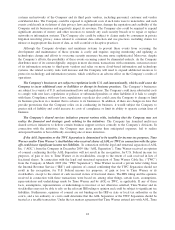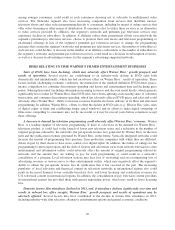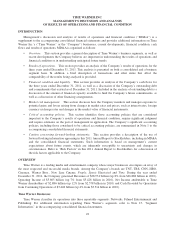Time Magazine 2011 Annual Report Download - page 34
Download and view the complete annual report
Please find page 34 of the 2011 Time Magazine annual report below. You can navigate through the pages in the report by either clicking on the pages listed below, or by using the keyword search tool below to find specific information within the annual report.among younger consumers, could result in such consumers choosing not to subscribe to multichannel video
services. The Networks segment also faces increasing competition from services that distribute movies,
television shows and other video programming directly to consumers, including by means of online services that
offer video streaming or other means of distribution. If consumers elect to utilize these services as an alternative
to video services provided by affiliates, the segment’s networks and premium pay television services may
experience declines in subscribers. In addition, if affiliates reduce their promotional efforts associated with the
segment’s premium pay television services, choose to promote their own movie and television programming or
on-demand offerings in lieu of the segment’s premium pay television services or change the programming
packages that contain the segment’s networks and premium pay televisions services, the number of subscribers to
such services could decline. A decrease in the number of an affiliate’s subscribers or the number of subscribers to
the segment’s networks and premium pay television services could result in a decrease in subscription revenues,
as well as a decrease in advertising revenues for the segment’s advertising-supported networks.
RISKS RELATING TO TIME WARNER’S FILMED ENTERTAINMENT BUSINESSES
Sales of DVDs have been declining, which may adversely affect Warner Bros.’ growth prospects and
results of operations. Several factors are contributing to an industry-wide decline in DVD sales both
domestically and internationally, which has had an adverse effect on Warner Bros.’ results of operations. These
factors include challenging economic conditions, the maturation of the standard definition DVD format, piracy,
intense competition for consumer discretionary spending and leisure and entertainment time and declining price
points. Subscription rental (including subscription streaming services) and discount rental kiosks, which generate
significantly less revenue for Warner Bros. than DVD sales, have been capturing an increasing share of consumer
transactions and consumer discretionary spending, which has adversely affected DVD prices and sales and could
adversely affect Warner Bros.’ ability to increase revenues from the electronic delivery of its films and television
programming. In addition, Warner Bros.’ efforts to offset the decline in DVD sales (e.g., Blu-ray Disc sales, sales
of digital copies of films and establishing longer rental windows) and its efforts to make digital ownership of
films more compelling to consumers may not be successful or it may be several years before consumers accept
these offerings.
A decrease in demand for television programming could adversely affect Warner Bros.’ revenues. Warner
Bros. is a leading supplier of television programming. If there is a decrease in the demand for Warner Bros.’
television product, it could lead to the launch of fewer new television series and a reduction in the number of
original programs ordered by the networks, the per-episode license fees generated by Warner Bros. in the near
term and the syndication revenues generated by Warner Bros. in the future. Vertically integrated networks could
increase the amount of programming they purchase from production companies with which they are affiliated,
driven in part by their desire to have more control over digital rights. In addition, the failure of ratings for the
programming to meet expectations and the shift of viewers and advertisers away from network television to other
entertainment and information outlets could adversely affect the amount of original programming ordered by
networks and the amount they are willing to pay for such programming or could result in a network’s
cancellation of a program. Local television stations may face loss of viewership and an accompanying loss of
advertising revenues as viewers move to other entertainment outlets, which may negatively affect the segment’s
ability to obtain the per-episode license fees in syndication that it has received in the past. The increasing
popularity of local television and theatrical content on television networks in international regions also could
result in decreased demand, fewer available broadcast slots, and lower licensing and syndication revenues for
U.S. television content in international regions. In addition, the consolidation of pay television content providers
in international regions has provided them with greater negotiating power, which may result in lower licensing
fees.
Domestic feature film attendance declined in 2011, and, if attendance declines significantly over time and
results in reduced box office receipts, Warner Bros.’ growth prospects and results of operations may be
adversely affected. Several factors may have contributed to the decline in feature film attendance in 2011,
including industry-wide film selection, alternative entertainment options and general economic conditions.
20
























